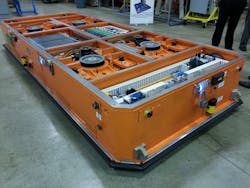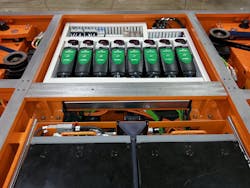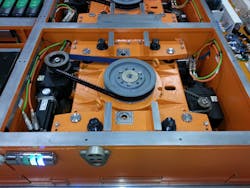The nuclear power industry’s loss is the material handling industry’s gain—at least in Canada. The government in Ontario has decided to pull back from commissioning new nuclear power plants. Instead they will refurbish existing facilities. Industry analysts believe this change in heart about nuclear power resulted from 2011’s earthquake-induced meltdown at Japan’s Fukushima nuclear power plant. The wider availability of reasonably-priced natural gas and renewable energy sources might have also been factors.
The Ontario Energy Ministry forecasts that Ontario's energy mix by 2025 will be 42 percent nuclear (from 59% today), 46 percent renewable (from 28 percent today), and 12 percent natural gas (from 11 percent today). To make that wind-down through plant refurbishing easier and safer they are using material handling automation in the form of automated guided vehicles—which use lithium-ion batteries for their power. These AGVs will move spent rods and other materials out of the plant. I saw a demonstration of these AGVs courtesy of their manufacturer, FORI Automation, at its plant in Shelby Township, Mich.
I saw two nuclear waste handling AGVs at work; one narrow and one wide. The larger version will be able to carry 60,000 lb. It will move flasks, which are secure containers for nuclear waste like spent rods. The AGVs will take them out of the vault through air lock doors to the outside where they will be transported to a secured disposal site.
Why AGVs for this task? For repeatability, accuracy and safety.
“You could move them manually but you would need an entire crew of people to make sure you don’t hit anything,” explained Martin Erni, Fori’s director of business development. “The narrow version can go through a 39-inch-wide door opening and carry about 15,000 pounds. They will also carry the material that goes in and out of the plants to do the refurbishment.”
There are five reactors to be refurbished. They will start with one and work around the clock, 24/7, 365 days a year until the first one is done; then they’ll refurbish the next one.“The AGVs have an open architecture so the customer can do modifications,” he said.
Sounds pretty sophisticated for hunks of machinery whose radioactive loads will eventually turn them into nuclear waste themselves. They will have a 10 year service life.
In those ten years, the AGVs will be equipped to handle a wide variety of loads. Their surfaces are flat and will have different bolt-on patterns to secure the loads, depending on the flask style. Their lithium-ion batteries are expected to last five years.
Although AGVs will eliminate labor, there will still be a spotter needed to hold the human-machine interface controller and walk with the vehicle in and out of the facility. Any downtime will have to be minimal if the system is to result in a return on investment, according to Erni.
“It costs $1 million a day to have a power plant down,” he adds. “When they unload the tubes they’ll need to be precisely located. Sometimes we’re talking about a half inch between the wall and the product, maneuvering through tight spaces. Once an AGV is in the vault it will automatically dock to a charging station and charge for 12 minutes—enough for it to go out and come back in again.”
Pretty dedicated to its duty, considering its fate.
About the Author
Tom Andel Blog
former Editor-in-Chief
As editor-in-chief from 2010-2014, Tom Andel oversaw the strategic development of MH&L and MHLnews.com, bringing 30+ years of thought leadership and award winning coverage of supply chain, manufacturing logistics and material handling. Throughout his career he also served in various editorial capacities at other industry titles, including Transportation & Distribution, Material Handling Engineering, Material Handling Management (predecessors to MH&L), as well as Logistics Management and Modern Materials Handling. Andel is a three-time finalist in the Jesse H. Neal Business Journalism Awards, the most respected editorial award in B2B trade publishing, and a graduate of Cleveland’s Case Western Reserve University.




